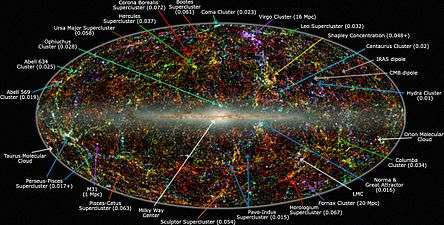Great Attractor


The Great Attractor is a gravitational anomaly in intergalactic space at the center of the Laniakea Supercluster that reveals the existence of a localised concentration of mass tens of thousands of times more massive than the Milky Way. This mass is observable by its effect on the motion of galaxies and their associated clusters over a region hundreds of millions of light-years across. The Great Attractor is moving towards the Shapley Supercluster.[1]
These galaxies are all redshifted, in accordance with the Hubble Flow, indicating that they are receding relative to us and to each other, but the variations in their redshift are sufficient to reveal the existence of the anomaly. The variations in their redshifts are known as peculiar velocities, and cover a range from about +700 km/s to −700 km/s, depending on the angular deviation from the direction to the Great Attractor.
Location
The first indications of a deviation from uniform expansion of the universe were reported in 1973 and again in 1978. The location of the Great Attractor was finally determined in 1986: it is situated at a distance of somewhere between 150 and 250 Mly (million light years) (47–79 Mpc) (the latter being the most recent estimate) from the Milky Way, in the direction of the constellations Triangulum Australe (The Southern Triangle) and Norma (The Carpenter’s Square).[2] While objects in that direction lie in the Zone of Avoidance (the part of the night sky obscured by the Milky Way galaxy) and are thus difficult to study with visible wavelengths, X-ray observations have revealed that the region of space is dominated by the Norma cluster (ACO 3627),[3][4] a massive cluster of galaxies containing a preponderance of large, old galaxies, many of which are colliding with their neighbours and/or radiating large amounts of radio waves.
Debate over apparent mass
In 1992, much of the apparent signal of the Great Attractor was attributed to the effect of Malmquist bias.[5] In 2005, astronomers conducting an X-ray survey of part of the sky known as the Clusters in the Zone of Avoidance (CIZA) project reported that the Great Attractor was actually only one tenth the mass that scientists had originally estimated. The survey also confirmed earlier theories that the Milky Way galaxy is in fact being pulled towards a much more massive cluster of galaxies near the Shapley Supercluster, which lies beyond the Great Attractor.[6]
Dark flow
"Dark flow" is an astrophysics term that describes a possible non-random component of the peculiar velocity of galaxy clusters. The measured velocity is the sum of that predicted by Hubble's Law added to a possible small, unexplained, "dark" velocity that flows in a direction common to the galaxy clusters.
Laniakea Supercluster
The proposed Laniakea Supercluster is defined as the Great Attractor's basin, encompassing the former superclusters of Virgo and Hydra-Centaurus. Thus the Great Attractor would be the core of the new supercluster.[7]
See also
References
- ↑ "What Is The Great Attractor? - Universe Today". Universe Today.
- ↑ "NASA - Hubble Focuses on "the Great Attractor"". Nasa.gov. 2013-01-18. Retrieved 2015-06-02.
- ↑ "[astro-ph/0006199] Galaxies behind the Milky Way and the Great Attractor".
- ↑ "NASA's Ask an Astrophysicist: The Great Attractor". Imagine.gsfc.nasa.gov. Retrieved 2015-06-02.
One theory claims the Great Attractor is a supercluster (possibly the Shapley Supercluster), "with Abell 3627 near its center."
- ↑ "A general analytical solution to the problem of Malmquist bias due to lognormal". Adsabs.harvard.edu. 1992-06-01. Retrieved 2015-06-02.
- ↑ "X-rays Reveal What Makes the Milky Way Move". Ifa.hawaii.edu. 2006-01-11. Retrieved 2015-06-02.
- ↑ Tully, R. Brent; Courtois, Helene; Hoffman, Yehuda; Pomarède, Daniel (2 September 2014). "The Laniakea supercluster of galaxies". Nature (published 4 September 2014). 513 (7516): 71–73. arXiv:1409.0880
 . Bibcode:2014Natur.513...71T. doi:10.1038/nature13674.
. Bibcode:2014Natur.513...71T. doi:10.1038/nature13674.
Further reading
- Dressler, Alan (1994). Voyage to the Great Attractor: Exploring Intergalactic Space. New York: Alfred A. Knopf. p. 355. ISBN 0-394-58899-1.
External links
- New Map Locates Milky Way in Neighborhood of 100,000 Galaxies. Nadia Drake, for National Geographic, 3 September 2014
- Cosmography of the Local Universe at Vimeo showing the Great Attractor